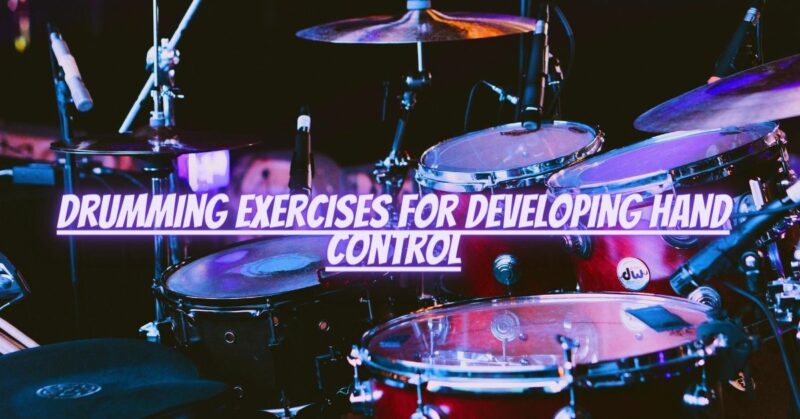Hand control is a fundamental aspect of drumming that allows drummers to execute precise rhythms, dynamic variations, and intricate patterns. Developing strong hand control enhances your technique, speed, and overall musicality. In this article, we will explore a series of drumming exercises specifically designed to improve hand control, enabling you to achieve precision, finesse, and versatility in your drumming. By incorporating these exercises into your practice routine, you can elevate your drumming skills and unlock new levels of control and expression.
- Single Stroke Rolls: Single stroke rolls are a cornerstone exercise for developing hand control. Start by playing alternating strokes (R-L-R-L…) on a practice pad or drum surface. Focus on maintaining an even volume and consistent tempo. Gradually increase the speed while keeping the strokes clean, controlled, and evenly spaced. Practice accenting different beats within the roll to develop control and dexterity.
- Finger Control Exercises: Finger control exercises help strengthen your fingers and improve dexterity. Place your fingers on a practice pad or drum surface and play controlled strokes using primarily your fingers, with minimal wrist or arm movement. Start with slow and deliberate strokes, gradually increasing the speed while maintaining precision and control. Experiment with different finger combinations and patterns to challenge your finger control further.
- Stick Control: The Stick Control exercise, developed by George Lawrence Stone, is a classic exercise for improving hand control and coordination. Practice the exercises from the Stick Control book, focusing on playing the prescribed patterns with consistency, accuracy, and controlled stick heights. Start at a comfortable tempo and gradually increase the speed while maintaining control and a smooth flow between different patterns.
- Dynamics Control: Developing control over dynamics is essential for expressive drumming. Practice playing controlled strokes at different dynamic levels, from soft to loud and everything in between. Focus on maintaining a balanced sound and consistent control over the volume of each stroke. Experiment with different stroke heights, finger pressure, and rebound to achieve the desired dynamics while maintaining precision and control.
- Accented Stroke Control: Accented strokes add depth and variety to your drumming. Practice playing patterns with controlled accents on specific beats or subdivisions. Start with simple accent patterns and gradually increase the complexity. Pay attention to maintaining consistent accents, while keeping the non-accented strokes controlled and even. This exercise enhances your ability to highlight specific notes while maintaining control over the entire pattern.
- Hand-to-Hand Exercises: Hand-to-hand exercises improve coordination and balance between your hands. Practice patterns that alternate between the right and left hand, such as paradiddles or double stroke rolls. Start slowly and gradually increase the speed while maintaining control and evenness between hands. Focus on synchronizing your hands and minimizing any inconsistencies in sound or timing.
- Flam Exercises: Flams are a versatile rudiment that require precision and control. Practice flam exercises, such as flam taps or flam accents, to develop control over the grace notes and the subsequent primary strokes. Pay attention to achieving a clean flam sound with a distinct separation between the grace note and the primary stroke. Gradually increase the speed while maintaining control and clarity.
- Rudimental Exercises: Incorporating rudiments into your practice routine is invaluable for hand control. Practice rudiments such as paradiddles, double strokes, flams, and ratamacues. Start slowly and gradually increase the speed while maintaining control, evenness, and consistency between the strokes. Focus on developing control and fluidity within each rudiment, allowing for seamless transitions between them.
- Stickings and Hand Switching: Developing control during stickings and hand switching is crucial for smooth and seamless transitions. Practice patterns that require alternating stickings or hand switching, such as paradiddle-diddles or sticking patterns across the drum set. Focus on maintaining control, consistency, and evenness while executing the stickings or hand switches. Gradually increase the complexity of the patterns to challenge your hand control further.


